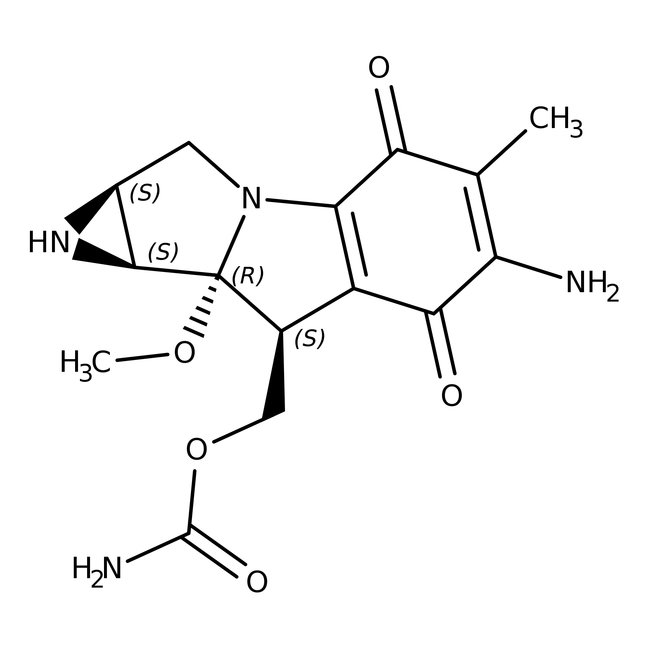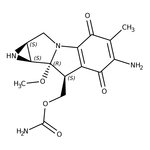Search Thermo Fisher Scientific
Mitomycin C, Thermo Scientific Chemicals
| Catalog Number | Quantity |
|---|---|
| FSKJ63193.MA | 10 mg |
This Thermo Scientific Chemicals brand product was originally part of the Alfa Aesar product portfolio. Some documentation and label information may refer to the legacy brand. The original Alfa Aesar product / item code or SKU reference has not changed as a part of the brand transition to Thermo Scientific Chemicals.
General Description
• Mitomycin C is a methylazirinopyrroloindoledione compound isolated from the bacterium Streptomyces caespitosus, and other Streptomyces bacterial species that has antineoplastic and antibiotic activities
• This compound acts as an inhibitor of DNA synthesis, nuclear division, as well as an apoptosis inducer. It can create oxygen radicals, and produce inter-strand DNA crosslinks, inhibiting DNA synthesis
• Mitomycin C shows alkylating activity and mainly targets the guanine nucleoside sequence 5′-CpG-3′. It inhibits DNA synthesis by covalently reacting with DNA, forming crosslinks between complementary strands of DNA. Consequently, this interaction prevents the separation of complementary DNA strands, inhibiting DNA replication
Application
• Mitomycin C is active against a broad-spectrum of gram-positive, gram-negative, and acid-fast bacilli bacteria
• Mitomycin C has strong antineoplastic activity, mainly against Ehrlich ascites tumor cell lines
• This compound can inhibit B and T cells and macrophage proliferation. It can also impair antigen presentation, as well as the secretion of interferon-γ, TNF- α, and IL-2
• This compound is used to generate mitotically inactive feeder cells in cell culture systems, such as the mitotically inactive fibroblasts used in embryonic stem cell systems
• It has been used to treat basal-like cancer cell line in vitro experiments
• It is particularly toxic to hypoxic cells inhibiting RNA and protein synthesis at high concentrations
General References:
- Yan, C.; Kong, D.; Ge, D.; Zhang, Y.; Zhang, X.; Su, C.; Cao, X. Mitomycin C Induces Apoptosis in Rheumatoid Arthritis Fibroblast-Like Synoviocytes via a Mitochondrial-Mediated Pathway. Cell. Physiol. Biochem. 2015, 35 (3), 1125-1136.
- Camarasa, M.; Brison, D.; Kimber, S.; Handyside, A. Naturally immortalised mouse embryonic fibroblast lines support human embryonic stem cell growth. Cloning Stem Cells. 2009, 11, (3), 453-62.
- Mao, Y.; Varoglu, M.; Sherman, D. Molecular characterization and analysis of the biosynthetic gene cluster for the antitumor antibiotic mitomycin C from Streptomyces lavendulae NRRL 2564. Chem Biol. 1999, 6, (4), 251-263.
- Tai, T. Y. T.; Moster, M. R.; Pro, M. J.; Myers, J. S.; Katz, L. J. Needle Bleb Revision with Bevacizumab and Mitomycin C Compared With Mitomycin C Alone for Failing Filtration Blebs. J. Glaucoma 2015, 24 (4), 311-315.



